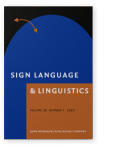Vol. 26:1 (2023) ► pp.1–36
Classifiers, argument expression, and age of acquisition effects in Turkish Sign Language (TİD)
This study investigates differences in language production of native, early-learner, and late-learner Turkish Sign Language (Türk İşaret Dili – TİD) signers in the domain of classifiers. For this study, we conducted a picture-signing task to elicit clauses with classifier constructions from adult Deaf signers of these three groups. The results indicate that there is no significant difference among these three groups with respect to the morphological encoding of thematic roles on verbal roots in classifier constructions. Nonetheless, a difference surfaces in the argument expression patterns among these groups. The data show that the age of exposure to a first linguistic input impacts the argument expression rates as well as which arguments are expressed or left unexpressed. Native signers drop the agent argument more frequently than early-learner and late-learner signers. Early-learner signers, in turn, drop the agent argument more frequently than late-learners. The data further indicate that perspective taking interacts with argument expression and age of acquisition. Overall, signers drop the agent more frequently under a character perspective than an observer perspective, with native and early-learner signers employing this strategy more than late-learner signers.
Article outline
- 1.Introduction
- 2.Background
- 2.1Description of classifiers
- 2.2Acquisition of classifiers and age of acquisition effects
- 3.Objectives
- 4.Methodology
- 4.1Participants
- 4.2Stimuli
- 4.3Procedure
- 4.4Annotations
- 5.Results
- 5.1Correspondence between argument structure and classifier type
- 5.2(C)overt expression of arguments in classifier constructions
- 5.3Perspective taking in classifier constructions
- 6.Discussion and conclusions
- Acknowledgements
- Notes
-
References
